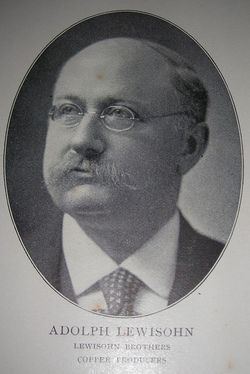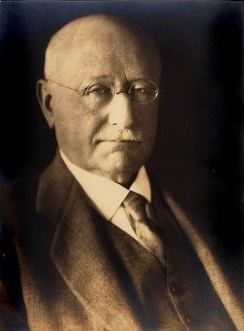Cause of death Heart attack Siblings Leonard Lewisohn Children Adele Lewisohn Lehman | Spouse Emma Cahn (m. 1878) Name Adolph Lewisohn | |
 | ||
Nieces Alice Lewisohn, Irene Lewisohn | ||
Adolph Lewisohn (May 27, 1849 – August 17, 1938) was a German Jewish immigrant born in Hamburg who became a New York City investment banker, mining magnate, and philanthropist. He is the namesake of the former School of Mines building on the Morningside Heights campus of Columbia University, as well as the former Lewisohn Stadium at the City College of New York. Time magazine called him "one of the most intelligent and effective workers on human relationships in the U.S."

Biography
Adolph Lewisohn was a son of Samuel Lewisohn (1809–1872) and his wife Julie (died 1856). He was born in Hamburg on May 27, 1849, and grew up with two brothers and four sisters. At the age 16 Adolph emigrated to New York City to assist his brothers, Julius and Leonard Lewisohn with the family's mercantile business, Adolph Lewisohn & Son which was named for his father. Adolph eventually became President of that business.
After meeting Thomas Edison in the 1870s, Adolph pushed the family firm to become involved with copper. Previously undervalued, copper's conductivity made it vital for a world that increasingly depended on electricity. In the 1880s, the brothers were among the first to invest in the copper mines of Butte, Montana. It proved to be a profitable venture, and they later established several new mining companies; including Tennessee Copper and Chemical Corporation of Ducktown, TN, General Development Company, Miami Copper Company of Miami, AZ, and the South American Gold and Platinum Company. Subsequently, Adolph and his brothers became "copper kings" with one of their mines paying 35 million in dividends by the 1890s. It was about this time that Adolph states he made all the money he wanted to make, and decided to stop and enjoy it.
Lewisohn was an avid collector art and items of historical interest, and was deep lover of classical music; in particular opera. He collected paintings, antiquities, decorative arts, manuscripts and rare books. He was particularly known for his extensive collection of works by artists from the Barbizon school and the later Impressionist artists. He was also an amateur singer, and every year on his birthday would sing opera arias to his birthday party guests up until the end of his life.
Lewisohn had a firm belief that everyone should be able to experience fine art, and much his philanthropic endeavours went towards making this vision happen. He donated a significant portion of his art collection to the Brooklyn Museum of Art, including “The Awakening” by Maurice Sterne, "Selina" by Jacob Epstein, and “Eve and the Apple,” by Kaj Neilsen. He was also a regular supporter of fine music in the New York. In addition to supporting local institutions like the Metropolitan Opera, he underwrote most of the costs of an annual Summer music concert series held at the Lewisohn Stadium. The series sported some of the best international performers in the classical world, and due to Lewisohn's generosity, ticket prices were very inexpensive and affordable to what he termed 'the every day man'. He was also an active philanthropist in the Jewish community, and served as President of the Hebrew Technical School for Girls.
Adolph married Emma Cahn on June 26, 1878, in Manhattan when he was 29 years old. Adolph Lewisohn died on August 17, 1938, at his Upper Saranac Lake camp, Prospect Point Camp.
